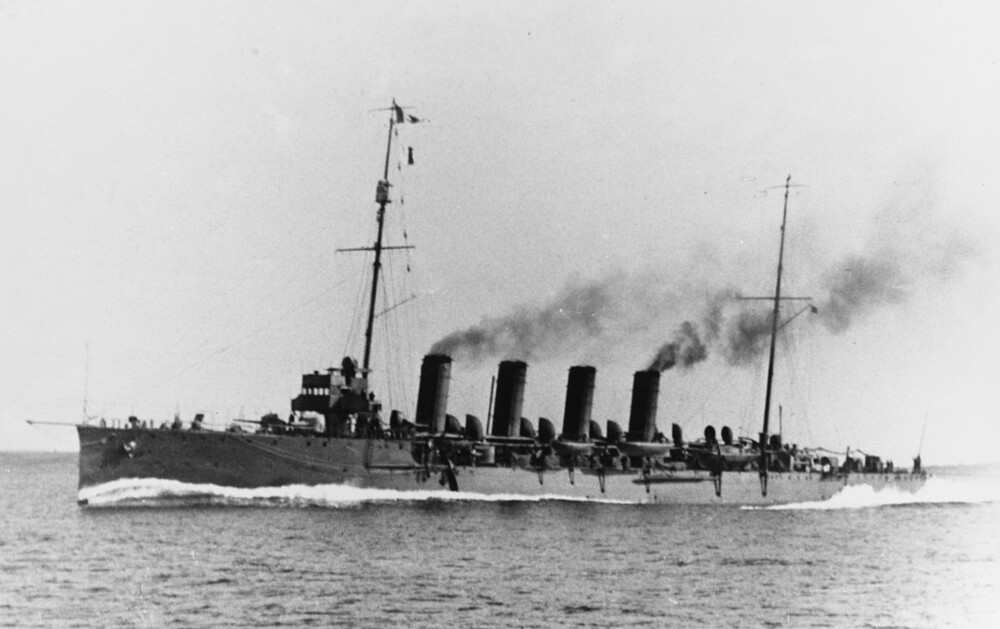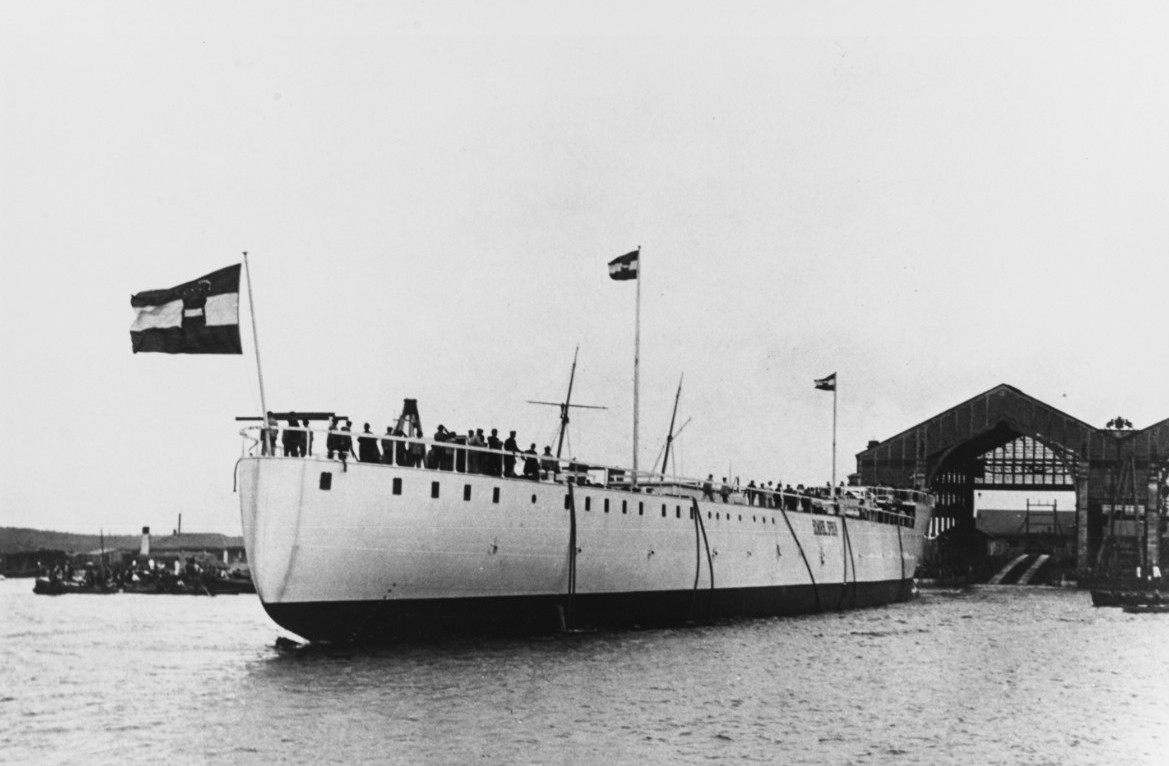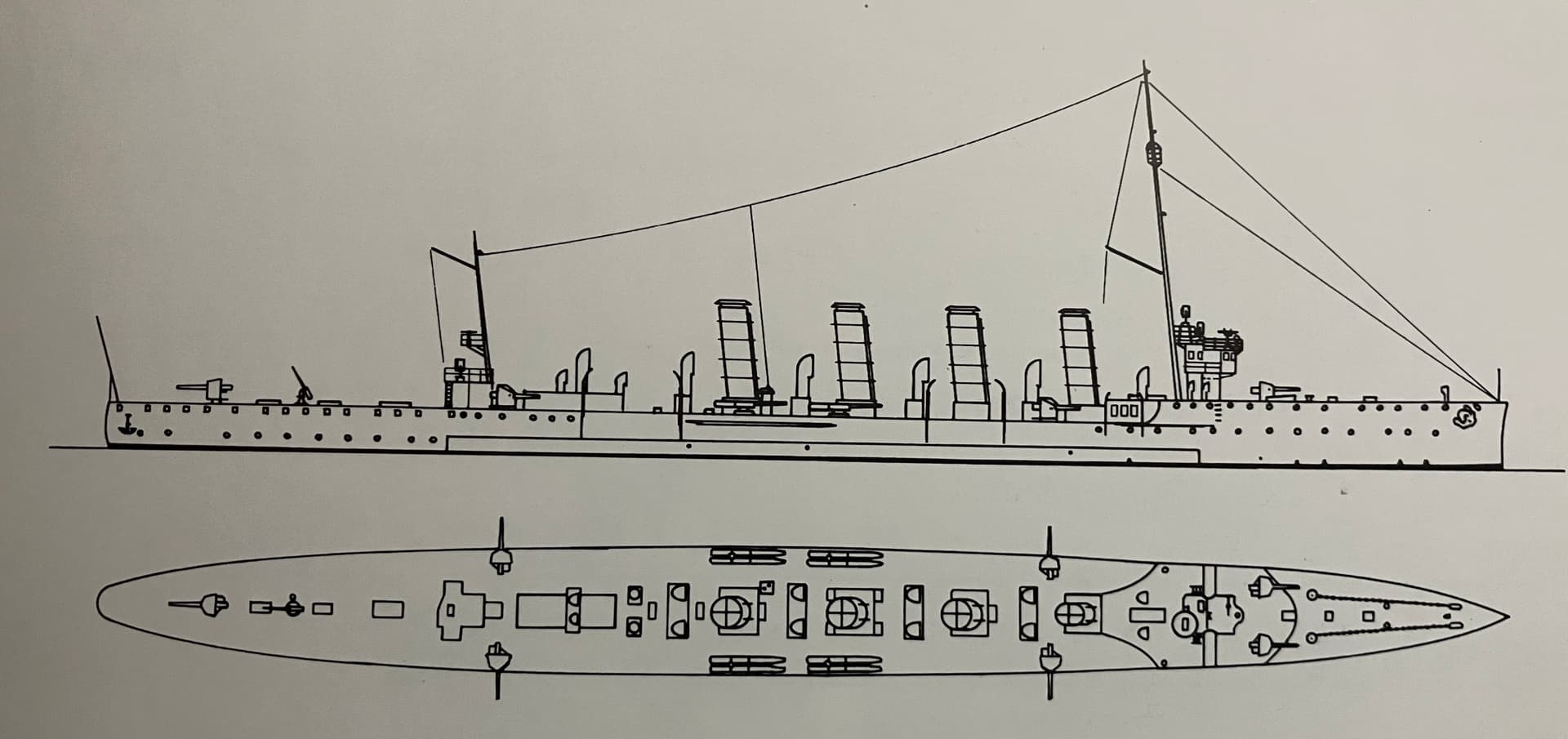- Yes
- No
- Austro-Hungarian Subtree in Italian tech tree
- Elsewhere in Italian tech tree
- Austro-Hungarian Subtree in German tech tree
- Elsewhere in German tech tree
- Other
- I said “No”
The first warship in the Austro-Hungarian Navy to be equipped with steam turbines, SMS Admiral Spaun and the subsequent Novara-class proved that the Adriatic theatre in WWI was not to be fought between battleships, but fast destroyers and their more powerful scout cruiser escorts.
Background & Service History
Background:
On January 5th, 1906, the Austro-Hungarian MTK (Marinetechnische Komitee, or Naval Technical Committee) received instructions from Admiral Montecuccoli to begin design on a new class of warship of 3,500t. Designated “Rapidkreuzer F” (also known as Ersatz Zara), this would be a scout cruiser, funded by Montecuccoli’s 1904 Fleet Expansion Program (which had a year earlier secured its required budget after a long period in the Dual Monarchy’s two parliamentary systems). The major requirement was the use of a relatively new technology - the steam turbine. Proven as a viable propulsion system in 1894 on the experimental Turbina and subsequently tested on a handful of torpedo boats and destroyers, Austro-Hungarian designers were much more interested in possible use for high-speed flotilla leaders.
At this point in time, the Austro-Hungarian Navy was attempting to claw its way into being a premiere naval power. Hulls, guns, torpedoes, and other warship components were being switched from ordered abroad to being domestically built - exchanging a cheaper cost for economic benefits each time a warship was ordered (this change to internal reliance is what would lead the Tegetthoff-class battleships to be the most expensive battleship in the world at the time of their construction). Unfortunately for the MTK, steam turbines had significant issues that would need several years to be overcome domestically, mainly a very poor range at low speed. By the time these issues were alleviated in 1905/06, when German engineer Hermann Föttinger developed a hydropump fluid coupling, the k.u.k. Kriegsmarine (Kaiserliche und Königliche Kriegsmarine, or Imperial and Royal War Navy) had already selected the Parsons design turbine. Shipbuilding and engineering company Stabilimento Tecnico Trieste, or STT, took up the task of designing and/or purchasing designs for Parson-style steam turbines. The early plans for STT engines in this fashion came with their own problems, as in early 1906 the MTK reported space problems fitting the turbines underneath the planned armor deck - requiring a complete overhaul of either the continuous armored deck plan or of the engine spaces, or at the very least a delay until November 1906 for design submission.
The last option was taken. When the designs were finally presented in late November, the MTK also prepared a comparison between their planned design and competing foreign designs - the British cruisers HMS Adventure and HMS Forward, the German cruiser SMS Emden, and the American cruiser USS Chester. Finding their warship compared favorably, the MTK was instructed to finalize design for a cruiser based off of these preliminary designs in January of 1907 and to proceed “with all possible speed.” The STT turbines were finally satisfactory by June 6th, 1907, with a range of 1,600 nautical miles at expected maximum speed (26 knots). The turbine construction contract amounted to around 4.8 million Kronen. Around the same time, tests with the outdated harbor ship SMS Zara showed that a 45cm torpedo launched from deck height would survive entering the water and remain fully functional.
The final obstacle with the design was hull strength. The length-to-beam ratio of the warship, combined with its short height, would require steel of a quality and tensile strength not readily achieved by Austrian and Hungarian steel companies. The steel companies were initially flat-out unwilling to produce such steel, and a conflict between the MTK and these companies broke out. As an attempt to strongarm these reluctant companies, the MTK proved how easy it would be to take their business elsewhere by purchasing several plates of high-tensile steel from Britain. Finally convinced, the Austrian and Hungarian firms conceded and began production of higher-tensile steel. Worries in the MTK were still high that the hull would be structurally weak, so from the ordering of Rapidkreuzer F in late 1907 to its launching in 1909, tests on steel strength were almost continuous. Videos, stress graphs, and eyewitness reports from the launching ceremony were also heavily recorded to affirm that the hull was structurally sound.
Rapidkreuzer F was officially named SMS Admiral Spaun upon launch. She was named after Montecuccoli’s predecessor and friend of the crown, Fleet Admiral Hermann von Spaun. She was commissioned on November 15th, 1910, as the first turbine powered warship of the k.u.k. Kriegsmarine.
Service History:
Upon her entrance into the navy, SMS Admiral Spaun was the pride of the Austro-Hungarian cruiser force. She successfully reached 27.07 knots on trial, over a full knot more than her design speed. Starting from 1911, she participated in several port visits with the new battleship SMS Radetzky, as well as the old warships of the Erzherzog Karl-class and the older still cruiser SMS Kaiserin und Königin Maria Theresa. When she returned, she was given the position of Flotilla Leader (“Führerschiff der Torpedoflotte”), and was present for the launching of SMS Viribus Unitis on the 24th of June, 1911. After minor refittings of her engine ventilation systems, she attended the launching of SMS Tegetthoff on the 22nd of March, 1912 - less than a week later she also had the honor of being one of the warships assembled for a visit from the German Kaiser Willhelm II.
Throughout 1913, not much action befell the Austro-Hungarian fleet. 1914, however, was a drastic change. After the assassination of Archduke Franz Ferdinand on June 28th, SMS Admiral Spaun sailed alongside SMS Tegetthoff and several torpedo boats to escort the battleship SMS Viribus Unitis, which was tasked with ferrying the corpse of Archduke Ferdinand and his wife Sophie back to the central area of the empire. This event would be the final straw in the pile of conflicts that soon lead to World War One.

The ensuing years of the war would reveal continuously recurring issues with the engines, but unlike the large warships in the k.u.k. Kriegsmarine, SMS Admiral Spaun would become very frequently used. In April, 1915, while rectifying engine troubles in drydock, her 2 single 45cm torpedo tubes were also replaced with 4 double mounted tubes of 53.3cm, reflecting the growing trust in such weapons. Aside from brief mobilization in 1914 to support the even more brief Austro-Hungarian support in the escape of SMS Goeben and SMS Breslau, Admiral Spaun would first see combat during the Bombardment of Ancona. While the battleships of the Tegetthoff- and Radetzky-classes provided the main source of artillery bombardment, SMS Admiral Spaun and her half-sisters of the Novara class served as fleet screens for the amassed Austro-Hungarian fleet. When the expected Italian response never appeared, the ships were reassigned to scouting duties and also provided small amounts of support in further bombardment of railways and other infrastructure before returning to port with the rest of the fleet.

SMS Admiral Spaun proceeded throughout the next several years of the war to be used in a much more extensive and frequent manner than ships any larger than her. Admiral Haus had adopted a “fleet-in-being” attitude, and considered it unwise to send out the larger battleships as long as a chance of Italian attack was existent. Because of this, smaller cruisers took up the mantle as the main warships from which the k.u.k. Kriegsmarine would assert its influence on the surrounding territory. Participating in many minor minesweeping, minelaying, and raiding missions, she was used slightly less than her half-sisters of the Novara-class due to the aforementioned engine trouble. In 1916, she also had her secondary armament overhauled - the addition of a 7cm K10 AA gun and a Schwarzlose M07/12 in an anti-aircraft mounting. SMS Admiral Spaun’s service remained fairly uniform, with the only change being a reallocation to the coastal defense at the port of Trieste in late 1917. Her final stints before the end of the war would be a coastal bombardment mission in December 1917 and a mobilization to help the ill-fated second raid attempt on the Otranto Barrage.
With the end of the war in sight, the Austro-Hungarian Government would attempt to keep their fleet out of Entente hands, and so they transferred it all to the newly formed State of Slovenes, Croats and Serbs. With the new flag flying above the now Yugoslav ship, the fleet stayed in port from October 31st, 1918 until the arrival of Italian warships 10 days later. The remainder of SMS Admiral Spaun’s service life consisted of sailing around Italy as a war prize. She was transferred to the British Fleet after the Treaty of Saint-Germain-en-Laye, but was almost immediately sold for scrap.
Specifications
Builder: Seearsenal Pola
Ordered: August 31, 1907
Laid down: May 30, 1908
Launched: October 30, 1909
Commissioned: November 15, 1910
Complement: 327 men.
Length: 130.64m (428ft 7in)
Beam: 12.79m (41ft 11.5in)
Draft: 4.58m (27ft 7in)
Displacement: 3,438t Standard, 4,007t Full Load.
16 Yarrow water-tube boilers, 6 Parsons-designed steam turbine engines, leading to 4 propeller shafts.
Speed & Power: 25,130 total SHP, 27.1 knots maximum speed.
Range: 1,600 nautical miles (2963km) at 26 knots.
Armor:
Main Belt: 60mm.
Gunshields: 40mm
Boiler Uptakes and Ammunition Elevators: 50mm
Deck: 20mm
Underwater protection: N/A
Armament:
7 x 10cm/50 K11 Škoda, 200 rounds per gun, 1,400 rounds total.
1 x 7cm/50 K10 Škoda BAG, 400 rounds per gun.
1 x 47mm L/44 SFK Hotchkiss, 400 rounds per gun.
1 x 8mm MG M 07/12 Schwarzlose, 4,000 rounds per gun.
8 x 53.3cm L7.18 Whitehead wet-heater torpedoes in 4 dual mounts.
Armament Specifics & Photos
Armament Specifics
- 10cm/50 K11 Škoda:
Shell diameter: 100mm (3.9-inch)
Shell types: SAP, AP
Shell specifications:
- SAP: “10cm Zündergranate” - 13.75kg, 1.3kg TNT bursting charge.
- AP: “10cm Panzergranate” - 13.75kg, ?kg TNT bursting charge.
Maximum range: 11,000m at 14 degrees elevation.
Velocity: 880m/s
Fire rate: 10 rounds per minute.
Mounting(s): Single-gun protected mounts, firing angles of -4/+14 degrees

- 7cm/50 K10 Škoda BAG
Shell diameter: 66.0mm (2.66-inch)
Shell types: HE
Shell specifications:
- HE: “7cm Sprenggranate” - 4.5kg, 1.6kg TNT bursting charge.
Maximum range: 5,000m Anti-Aircraft ceiling.
Penetration: N/A
Velocity: 880m/s
Fire rate: 20 rounds per minute
Mounting(s): Single-gun swivel mount, firing angles of -6/+90 degrees.

-47mm SFK L/44 Škoda/Hotchkiss
Shell diameter: 47.0mm (1.85-inch)
Shell types: SAP
Maximum range: 4,000m
Velocity: 710m/s
Fire rate: 25 rounds per minute
Mounting(s): Single-gun swivel mount, firing angles of -6/+90 degrees.
MG M.7/12 Schwarzlose
Round diameter: 8.2mm (0.323-inch)
Round types: N/A
Maximum range: N/A
Velocity: 620m/s
Fire rate: 580 rounds per minute
Mounting(s): Single-gun Anti-Aircraft swivel mount
- 53.3cm L7.18 Whitehead Torpedo
Torpedo diameter: 533mm (21-inch)
Torpedo specifications:
- 1590kg, 7.18m long, 180kg TNT explosive charge.
Maximum range: 1,000m at 41 knots (75.9km/h) or 10,000m at 36 knots (66.7km/h).
Mountings: 4 above-water dual mounts, 2 mounted on each broadside.
Yours truly,
KewlPangolin
Sources:
Kreuzer und Kreuzerprojecte der k.u.k. Kriegsmarine, 1889-1918 by Erwin Sieche, 2002
The Naval Policy of Austria-Hungary, 1867-1918 by Lawrence Sondhaus, 1994
NavWeaps - Austro-Hungarian Naval Guns
NavWeaps - Austro-Hungarian Torpedoes
Kriegsmarine.at - SMS Admiral Spaun








